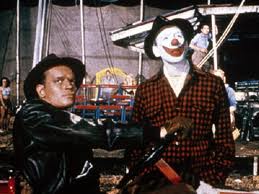“When the Romans were marching me to the galleys, thirst had almost killed me. A man gave me water to drink, and I went on living. I should have done better if I’d poured it into the sand!…I’m thirsty still.” – Judah Ben-Hur, discussing his unquenchable rage, Ben-Hur
Ben-Hur is perhaps the apex of the “Bigger is Better” philosophy that encapsulated many of the Best Pictures of this time frame. Ben- Hur is the sort of loud, over-the-top movie, loaded with massive sets and scenes with literally thousands of extras that would make even Michael Bay take pause. It also is a prime example of the Biblical Epic, a 1950s sub-genre that combined Bible stories with action spectacle and very long run times (like 1956’s The Ten Commandments). The two come together in Ben-Hur to create the most macho story about Jesus ever told. Of all which is a very long winded introduction to say BEN-HUR RULED IT!
Ben-Hur (aka A Tale of the Christ) is a look at what some of the other people in Judea were up to while Jesus was stirring up trouble. Charlton Heston, who never met a scene he couldn’t chew, is Judah Ben-Hur, a Judean prince. Although he was once friendly with Messala (Stephen Boyd), a Roman military commander, a rift has developed between the two due to Judea’s growing displeasure with Roman occupation. When welcoming the new Roman governor to town, Ben-Hur’s sister accidentally knocks a tile onto the governor. Suddenly Ben-Hur’s mother and sister are sent to jail and he is exiled to life as a slave rower on a battle ship. After an EPIC fight, Ben-Hur saves the life of boat commander Quintus Arrias (Jack Hawkins). Arrias adopts Ben-Hur and teaches him to chariot race. Ben-Hur finally returns to Judea after five years only to find his mom and sister are now lepers. Enraged, he challenges Messala to a chariot race (where, as Ben-Hur’s financier sheik points out “There is no law.”) Messala is killed in the demolition derby-style race, but Ben-Hur’s thirst for vengeance against Rome cannot be satiated. Throughout the story, Ben-Hur has crossed paths with an unseen peaceful figure, most notably when the anonymous man gives him water during a forced march through the desert. Finally Ben-Hur’s quasi-girlfriend convinces him to take his family to see Jesus (who is in the middle of being tried and crucified) and Ben-Hur finally learns peace. And his family is cured as an added bonus.

Ben-Hur (Charlton Heston) and friend-turned-rival Messala (Stepehen Boyd). According to the book Inside Oscar, one of the movie’s five writers intentionally added homoeroticism to the relationship, but Heston was left in the dark about it.
On the one hand, the events I described seem rather insane, and to a rational person perhaps they are. It is rare, for example, that faulty architecture play such a central role to a plot or the term Chariot Death Race makes its way into a highly-respected, Oscar winning film. But Ben-Hur has such a go-for-broke aplomb about it that I couldn’t help but enjoy it. Even Charlton Heston, who is frankly, a terrible actor, brings such ridiculous bravado to his role (Is he crying? Grinning? Who can tell? Why is he so damn macho all the time?!?) that it propels the story. He’s the action hero of the Biblical age.
In all seriousness, the movie has two magnificent action sequences – the boat battle and especially the chariot race. The chariot race – which took months to plan and five weeks to film with reportedly 15,000 extras – was a marvel of its time and is still an inspiration to movies like the pod-racer chase in Star Wars: The Phantom Menace. The race is more than 15 minutes long and non-stop action. And yet, unlike many action scenes of the past (and present), I never got confused about what was going on. The director really does a great job of laying out the action in a logical, visually understandable manner. And the stunts are crazy. The battle of the boats – where the boats ram one another and the slaves’ revolt – is also quite exciting and a great triumph of pre-CGI special effects.

I felt remiss about leaving out Hugh Griffith, who won the Best Supporting Actor award, despite playing a very minor, and fairly racist, role.
Ben-Hur is not without its flaws. The movie is very long – 3 ½ hours, and after the chariot race – with about 45 minutes to go in the movie – really grinds to a halt as Ben-Hur goes on and on about his family’s fate. A lot of the middle could have probably been cut down to a 2:45 movie as well.
Ben-Hur is probably the closest approximation to today’s big budget blockbuster action movies to win the Best Picture award (Wings is an action movie of sorts, Casablanca is a thriller but doesn’t have a big fight scene). I’d hate to think of it as the Transformers of its day, since as noted the action scenes in Ben-Hur are comprehensible. Hearing it described as a Biblical epic made me dread this movie, but I was pleasantly surprised at its excitement and general craziness.
Trivia: Ben-Hur won 11 Oscars, a record which still stands to this day (Titanic and Lord of the Rings: Return of the King have tied it).
Other Oscars Won: Best Actor, Charlton Heston; Best Supporting Actor: Hugh Griffith; Best Director: William Wyler; Best Cinematography, Color; Best Art Direction-Set Decoration, Color; Best Costume Design, Color; Best Sound, Color; Best Film Editing; Best Effects, Special Effects; Best Music (It lost Best Adapted Screenplay!)
Box Office: $37 Million (#1 for the year)
Other Notable Movies of 1959: Sleeping Beauty, North by Northwest, Some Like It Hot, Pillow Talk, Imitation of Life, Suddenly Last Summer, On the Beach, Anatomy of a Murder*, Rio Bravo, Room at the Top*, The Diary of Anne Frank*, The Nun’s Story*
*Best Picture Nominee






